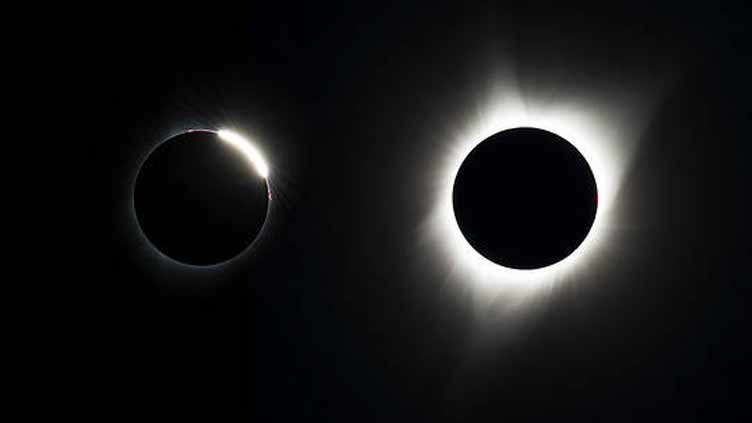NASA funds thee citizen science projects to study 2024 US solar eclipse

Technology
'During next year’s total eclipse, hundreds of volunteers will capture images of Sun and its corona'
(Web Desk) - NASA has awarded funding for three science teams to conduct citizen science investigations as a total solar eclipse sweeps across North America on April 8, 2024. In these experiments, volunteers will help study the Sun and its ethereal outer atmosphere, called the corona, which is revealed when the Moon completely covers the Sun’s bright disk.
“During next year’s total eclipse, hundreds of volunteers will capture images of the Sun and its corona to help answer real science question about our star and how it affects us,” said program scientist and eclipse lead at NASA Headquarters, Kelly Korreck.
“These three projects will build upon citizen scientific efforts from the 2017 solar eclipse and allow a multitude of ways to participate in the eclipse during the Heliophysics Big Year,” said NASA Heliophysics citizen science lead, Elizabeth MacDonald. “Volunteers make this important research possible, and we look forward to seeing what they help reveal.”
The DEB Initiative: Documenting the Corona Moment by Moment
In visible wavelengths of light, the Sun’s surface is much brighter than its corona. During a total solar eclipse, however, observers can see the corona – and scientists can investigate how solar material moves out from the Sun to form the solar wind, an ever-flowing particle stream that impacts Earth and our entire solar system.
The Dynamic Eclipse Broadcast (DEB) Initiative, led by Bob Baer and Matt Penn of Southern Illinois University in Carbondale, will organize volunteers as they capture images of the corona during the 2024 eclipse. Using identical instruments at more than 70 different locations across North America, participants will document the moment-by-moment appearance of the corona throughout the eclipse. Comparing these images across locations, scientists will track plumes of solar material in the difficult-to-study inner corona, estimating their speed and rate of acceleration and linking these observations to those from NASA spacecraft.
The project expands on the team’s efforts during the 2017 total solar eclipse, this time including observation sites outside the path of totality, where part of the solar disk will remain visible. Images from these locations will reveal the source of solar material later observed as outflows in the corona, allowing the team to trace them back to their origins on the Sun.
CATE 2024: Capturing Polarized Views of the Corona
With the help of over 35 volunteer science teams across the U.S., the Citizen Continental-America Telescopic Eclipse (CATE) 2024 experiment aims to study structures and changes in the corona and solar wind. This project, led by Amir Caspi of the Southwest Research Institute in Colorado, will do that by taking images of the corona in polarized light.
Light travels in waves, but those waves can be oriented in different directions, or polarization angles. Similar to how some sunglasses can filter out certain light polarizations, the CATE 2024 cameras will record in four different polarizations. This will help measure the flow of the solar wind, identify signatures of an explosive process thought to generate the solar wind, and understand how structures in the corona are connected.
Each participating team will receive a camera, a telescope, tracking mount, and other supporting equipment. Their images will be compiled into a 60-minute high-contrast movie that scientists will compare with other eclipse observations, including those from NASA space missions. This will help scientists study the processes that shape the heating, structure, and evolution of the corona.
CATE 2024 builds on the Citizen CATE 2017 experiment by using cameras that have a larger field of view and are sensitive to polarization, allowing them to make unique measurements of coronal structures and flows.
Eclipse Megamovie 2024: Recording Dynamics Across the Corona
Total solar eclipses not only reveal the Sun’s corona but can also show the thin layer of the Sun’s atmosphere just below the corona, called the chromosphere. Taking advantage of this unique view, the Eclipse Megamovie 2024 project, led by Laura Peticolas of Sonoma State University in California, will enlist citizen scientists to explore and characterize how superheated gas (plasma) flows through the corona and chromosphere, as well as through the jets, or tendrils of plasma, in those regions.
For this project, at least 100 trained volunteers will take photographs of the total solar eclipse, using cameras on equatorial mounts to compensate for Earth’s rotation. Afterward, the project will provide over 1,200 eclipse photos to scientists and the public. Eclipse Megamovie 2024 will challenge volunteer photographers and data analysts to participate in an image-processing competition to uncover plasma flows and jets in the images.
Eclipse Megamovie 2024 will also compare observations of the eclipse with results from the 2017 Eclipse Megamovie. Peticolas expects that with an increased number of photographs that have different exposure times, the processed images from 2024 will be more visually stunning than those from 2017. Since the Sun is becoming more active – approaching a period known as solar maximum – citizen scientists will also likely capture more activity in the corona and chromosphere than in 2017, providing a wealth of new information.

